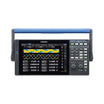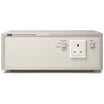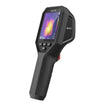
Safran Skydel GSG-8 GEN2 GNSS Simulator
Use our chat for personal support or contact us via +45 31 33 18 19 or salg@GOmeasure.dk
- 2000+ signals
- All MF/MC Signals via Individual or Composite Port
- Up to 6 vehicle or antennas in a simulation
- Simulate jamming, spoofing, meaconing, interference of all kind
- Unlimited number of jammers
- 1000 Hz simulation iteration rate
- Available in three configurations with up to 6 SDRs
- Sub-nanosecond-level synchronization between RF bands
- High-end RF quality
- Simulate hundreds of satellites in real time
- Multi-vehicle simulation
- API (Python, C#, C++)
- IQ file generation and playback
Discover the possibilities
More information
Description
Safran’s GSG-8 Gen2 is an evolution of the popular GSG-8. An expert-level positioning, navigation, and timing test solution offered through Safran’s family of Skydel-based simulators.
The GPU-based GSG-8 Gen2 simulator delivers the highest standard of GNSS signal testing in an easy-to-use, turnkey form factor supporting the growing need for location-aware applications and systems that require navigation or timing. With 6 front-facing high-quality RF outputs and a combined one, the GSG-8 Gen2 GNSS simulator covers the entire GNSS bandwidth and features high-end performance with a 1000 Hz simulation iteration rate, high dynamics, real-time synchronization, and simulation of all-in-view satellite signals.
The GSG-8 Gen2 is ideal for development, NavWar testing, and integration projects that require very high performance and an increased number of constellations and satellites in view, and multi vehicle / multi antenna scenarios.
With the GSG-8 Gen 2 Simulator, you can generate RF signals to simulate how your receiver device will react in the real world, under the simulation parameters that you set. Control every aspect of your simulation, including 6 Degrees of Freedom (DoF) receiver trajectories, multipath signals, advanced jamming and spoofing, as well as atmospheric interferences.
Features
- 2000+ signals
- All MF/MC Signals via Individual or Composite Port
- Up to 6 vehicle or antennas in a simulation
- Simulate jamming, spoofing, meaconing, interference of all kind
- Unlimited number of jammers
- 1000 Hz simulation iteration rate
- Available in three configurations with up to 6 SDRs
- Sub-nanosecond-level synchronization between RF bands
- High-end RF quality
- Simulate hundreds of satellites in real time
- Multi-vehicle simulation
- API (Python, C#, C++)
- IQ file generation and playback
Specs
- Power Consumption: 1600W
- Compatible bands: L1, L2, L5, E6, S-band
- Signals:
- GPS: L1 C/A, L1C, L1 P(Y), L2 P(Y), L2C, L5
- Galileo: E1, E5a, E5b, E5 AltBOC, E6 HAS, PRS (Restricted Signals)
- GLONASS: G1, G2
- BeiDou:
- BeiDou-2 (BDS-2): B1, B2
- BeiDou-3 (BDS-3): B1C, B2a, B3I
- QZSS: L1 C/A, L1 C/B, L1S, L2C, L5, L5S
- NavIC (IRNSS): L1, L5
- SBAS (Satellite-Based Augmentation Systems): L1, L5
- Xona: PULSAR XL
- Custom Signals: User-defined signals
- CDM-7 Timing Module
- High-end GPUs
Advantages
Advanced Jamming & Spoofing
The jamming and spoofing capabilities allow you to simulate all types of interference that can occur in the real world – whether benign or malicious. You can set the power level, interference signal type, spoofing signals, location, antenna pattern and trajectory for each transmitter. You’ll be able to generate in-band and out-of-band jamming signals, with no additional hardware required.
Multi-Signal/Frequency
With multiple satellite constellations – both global, local, and LEO — providing signals for navigation and geospatial applications, the number of signals and frequencies being emitted, augmented, and echoed is staggering. Simulating all these aspects is a challenge for FPGA-based simulators which are not capable of generating an increased number of signals in view.
Skydel-based systems like the GSG-8 have successfully overcome this technological hurdle by leveraging the immense computational power of modern GPUs (Graphics Processing Units) to simulate well up to 2000 GNSS signals with maximum flexibility across multiple bands – simultaneously!
Multi-Vehicle/Antenna
When testing unmanned aerial vehicles (UAVs) such as drones, or aircraft
(with one antenna per wing), or spacecrafts, GNSS simulators can generate
a signal to represent multiple antennas and/or vehicles. But how those
antennas/vehicles interact with others and perform in GPS and GNSS-denied
environments can make all the difference in their performance. And many
applications rely on multiple antennas for positioning and heading.
From a single GSG-8 Gen2, users can run and control multiple instances
(running on the same hardware), each one representing an independent
trajectory, vehicle, or antenna – each with its own output connector.
LEO PNT
LEO PNT GNSS constellation are being launched into space with increased
frequency, and with it comes a great deal of promise (security, accuracy,
indoor GNSS). Like GNSS, LEO PNT relies on GNSS simulation to be developed
and used – from the signal definition to receiver integration in systems.
The GSG-8 Gen2 is a state-of-the-art LEO PNT signal simulator. No other
platform is able to generate the high number of signals needed for LEO PNT
simulations in addition to legacy GNSS signals, threats, and multipaths. This
high capacity also allows the GSG-8 Gen2 to generate S-Band signals in
addition to the above.
Use Cases
Multi-Antenna GNSS Simulation for Unmanned Aerial Vehicles (UAVs)
Safran’s Skydel GPS/GNSS Simulators enable cost-effective, scalable multi-antenna testing for UAV applications.
Multi-Antenna GNSS Simulation for Automotive Applications
Safran’s Skydel GPS/GNSS Simulators enable cost-effective, scalable multi-antenna testing for automotive applications.
GNSS Simulation for Space Launch Applications
Safran’s Skydel software simulates the trajectory of space vehicles as they launch and travel into orbit.
Case Studies
Orolia to provide Becker Avionics with GSG-8 with fully operational SBAS function to test avionics receiver
Orolia supplied a Skydel-based GSG-8 Advanced Simulator with advanced jamming and spoofing options to test the avionic receiver in real-life conditions.
GSG-8 and SecureSync Platforms Combined to Support GMV in the RIPTIDE Project
Discover how GMV utilized the GSG-8 and SecureSync platforms in the development of a robust PNT framework to limit the impact of GNSS vulnerabilities on maritime and inland waterways’ PNT applications within the Black Sea and Danube Lower Basin region.
Safran’s GSG-8 Advanced Simulator Drives R&D Testing for Stellantis (formerly FCA – Fiat Chrysler Automobiles)
Discover how the flexible and scalable GSG-8 platform delivered a cost-effective and high-end precision GNSS testing to the automotive industry.
Specifications
Documents
Options
Video
Safran’s GSG-8 Gen2 is an evolution of the popular GSG-8. An expert-level positioning, navigation, and timing test solution offered through Safran’s family of Skydel-based simulators.
The GPU-based GSG-8 Gen2 simulator delivers the highest standard of GNSS signal testing in an easy-to-use, turnkey form factor supporting the growing need for location-aware applications and systems that require navigation or timing. With 6 front-facing high-quality RF outputs and a combined one, the GSG-8 Gen2 GNSS simulator covers the entire GNSS bandwidth and features high-end performance with a 1000 Hz simulation iteration rate, high dynamics, real-time synchronization, and simulation of all-in-view satellite signals.
The GSG-8 Gen2 is ideal for development, NavWar testing, and integration projects that require very high performance and an increased number of constellations and satellites in view, and multi vehicle / multi antenna scenarios.
With the GSG-8 Gen 2 Simulator, you can generate RF signals to simulate how your receiver device will react in the real world, under the simulation parameters that you set. Control every aspect of your simulation, including 6 Degrees of Freedom (DoF) receiver trajectories, multipath signals, advanced jamming and spoofing, as well as atmospheric interferences.
Features
- 2000+ signals
- All MF/MC Signals via Individual or Composite Port
- Up to 6 vehicle or antennas in a simulation
- Simulate jamming, spoofing, meaconing, interference of all kind
- Unlimited number of jammers
- 1000 Hz simulation iteration rate
- Available in three configurations with up to 6 SDRs
- Sub-nanosecond-level synchronization between RF bands
- High-end RF quality
- Simulate hundreds of satellites in real time
- Multi-vehicle simulation
- API (Python, C#, C++)
- IQ file generation and playback
Specs
- Power Consumption: 1600W
- Compatible bands: L1, L2, L5, E6, S-band
- Signals:
- GPS: L1 C/A, L1C, L1 P(Y), L2 P(Y), L2C, L5
- Galileo: E1, E5a, E5b, E5 AltBOC, E6 HAS, PRS (Restricted Signals)
- GLONASS: G1, G2
- BeiDou:
- BeiDou-2 (BDS-2): B1, B2
- BeiDou-3 (BDS-3): B1C, B2a, B3I
- QZSS: L1 C/A, L1 C/B, L1S, L2C, L5, L5S
- NavIC (IRNSS): L1, L5
- SBAS (Satellite-Based Augmentation Systems): L1, L5
- Xona: PULSAR XL
- Custom Signals: User-defined signals
- CDM-7 Timing Module
- High-end GPUs
Advantages
Advanced Jamming & Spoofing
The jamming and spoofing capabilities allow you to simulate all types of interference that can occur in the real world – whether benign or malicious. You can set the power level, interference signal type, spoofing signals, location, antenna pattern and trajectory for each transmitter. You’ll be able to generate in-band and out-of-band jamming signals, with no additional hardware required.
Multi-Signal/Frequency
With multiple satellite constellations – both global, local, and LEO — providing signals for navigation and geospatial applications, the number of signals and frequencies being emitted, augmented, and echoed is staggering. Simulating all these aspects is a challenge for FPGA-based simulators which are not capable of generating an increased number of signals in view.
Skydel-based systems like the GSG-8 have successfully overcome this technological hurdle by leveraging the immense computational power of modern GPUs (Graphics Processing Units) to simulate well up to 2000 GNSS signals with maximum flexibility across multiple bands – simultaneously!
Multi-Vehicle/Antenna
When testing unmanned aerial vehicles (UAVs) such as drones, or aircraft
(with one antenna per wing), or spacecrafts, GNSS simulators can generate
a signal to represent multiple antennas and/or vehicles. But how those
antennas/vehicles interact with others and perform in GPS and GNSS-denied
environments can make all the difference in their performance. And many
applications rely on multiple antennas for positioning and heading.
From a single GSG-8 Gen2, users can run and control multiple instances
(running on the same hardware), each one representing an independent
trajectory, vehicle, or antenna – each with its own output connector.
LEO PNT
LEO PNT GNSS constellation are being launched into space with increased
frequency, and with it comes a great deal of promise (security, accuracy,
indoor GNSS). Like GNSS, LEO PNT relies on GNSS simulation to be developed
and used – from the signal definition to receiver integration in systems.
The GSG-8 Gen2 is a state-of-the-art LEO PNT signal simulator. No other
platform is able to generate the high number of signals needed for LEO PNT
simulations in addition to legacy GNSS signals, threats, and multipaths. This
high capacity also allows the GSG-8 Gen2 to generate S-Band signals in
addition to the above.
Use Cases
Multi-Antenna GNSS Simulation for Unmanned Aerial Vehicles (UAVs)
Safran’s Skydel GPS/GNSS Simulators enable cost-effective, scalable multi-antenna testing for UAV applications.
Multi-Antenna GNSS Simulation for Automotive Applications
Safran’s Skydel GPS/GNSS Simulators enable cost-effective, scalable multi-antenna testing for automotive applications.
GNSS Simulation for Space Launch Applications
Safran’s Skydel software simulates the trajectory of space vehicles as they launch and travel into orbit.
Case Studies
Orolia to provide Becker Avionics with GSG-8 with fully operational SBAS function to test avionics receiver
Orolia supplied a Skydel-based GSG-8 Advanced Simulator with advanced jamming and spoofing options to test the avionic receiver in real-life conditions.
GSG-8 and SecureSync Platforms Combined to Support GMV in the RIPTIDE Project
Discover how GMV utilized the GSG-8 and SecureSync platforms in the development of a robust PNT framework to limit the impact of GNSS vulnerabilities on maritime and inland waterways’ PNT applications within the Black Sea and Danube Lower Basin region.
Safran’s GSG-8 Advanced Simulator Drives R&D Testing for Stellantis (formerly FCA – Fiat Chrysler Automobiles)
Discover how the flexible and scalable GSG-8 platform delivered a cost-effective and high-end precision GNSS testing to the automotive industry.























































































































